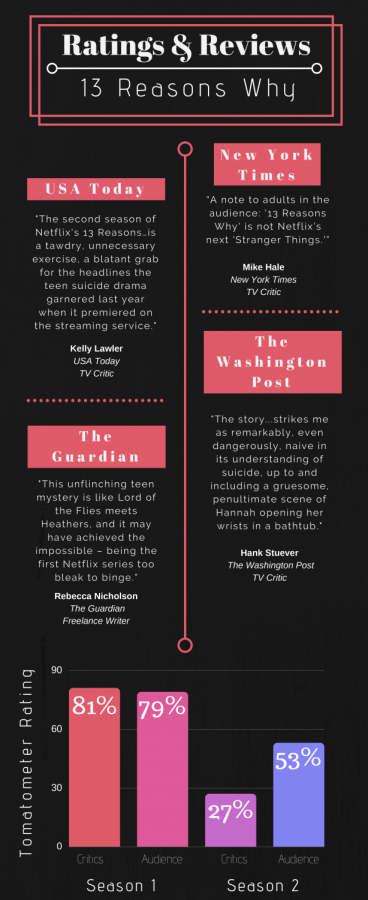Graphic media: How far is too far?
Sources: The Guardian, The Washington Post, USA Today, Rotten Tomatoes, New York Times Graphic by Emily Mann
November 7, 2018
In today’s television and media, we’ve begun to desensitize ourselves to the more graphic scenes seen in some of the most popular shows today. The repeated graphic scenes in “13 Reasons Why” has shown this over and over again. While the shows warn about particularly graphic episodes, it does little to prepare you for some of the more volatile scenes it shows.
I’m referring to the final episode of each season in particular for this television show. Both depict a very graphic scene which doesn’t contribute directly to the story. Especially considering in the highly controversial scene where Hannah kills herself, it was originally written to be overdose by pills. The original book by Jay Asher never says what had happened it simply says that there are rumors that it was an overdose.
The writers of the show made an active decision to depict the suicide in a more controversial way. This in turn gave the show more publicity even if it was bad. The show did this even with running the risk of suicide contagion. Suicide contagion is when a suicide is heavily publicized and linked to an increase in suicide rates. It can lead to copycat suicides and is highly dangerous which is why the American Foundation for Suicide prevention published guide lines on how the subject is supposed to be reported on.
The second scene was extremely graphic and depicted a student being sodomized by another student. While Netflix did put warnings at the beginnings of episodes, there are very few things that can truly prepare someone for the horrible scene.
On the other hand, the show “Game of Thrones” shows graphic materials throughout every single episode.
What differentiates it from a show like “13 Reasons Why” is that the graphic material included is there to benefit the story and it contributes to the overall show.
In HBO’s “Game of Thrones,” the blood and violence they show is an accurate reflection of what medieval times were like in period of war and conquest. Compared to “13 Reasons Why” it’s completely different because most every high school does not have those kinds of situations happening.
And yes, selfharm and suicide does happen to some in high school but “13 Reasons Why’s” coverage of that issue was nothing short of inflammatory and looking for some kind of response, good or bad.



